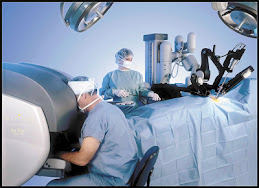http://news.nationalgeographic.com/news/2001/09/0919_robotsurgery.html
Article in National Geographic News
September 19th, 2001
This article discusses a medical landmark: a surgery, done in two different countries, by simply using a remote control. For this surgery, the surgeons were in New York City while the patient, whose gallbladder was being removed, was in Strasbourg, France. The surgeons used the ZEUS robotic system to complete this surgery, which consisted of robotic arms wielding a camera used to view the internal organs and two other robotic arms holding the actual surgical instruments to perform the operation. The surgery was successful after 54 minutes, and the patient had no complications.
The article emphasizes that while this is a huge medical advance in laproscopic surgery, the robotic tool utilized is not a “smart machine” it is only a tool which is guided by trained surgeons. While this surgery was successful, there are still technical issues that need to be addressed. The major issue is the time lag in transmission of signals from the surgeon's console to the operating room and back; for this particular surgery the time lag was 330 milliseconds, which was sufficiently safe to allow the surgeon to correctly and safely complete the procedure. The new technological advancements in this field will have to focus on
This successful surgery is a first step to eventually having an interconnected, telecollaborative surgery network without any borders. As the technology expands, the hope is that this type of surgery will be used for telementoring, teaching, and performing rare surgery. Also, as technology becomes portable, it will hopefully be utilized in disaster sites, battlefields, and developing countries where no surgeons are present. Surgeons are “hopeful that the new technology will help raise health standards around the world and make medical expertise more widely available.”
The article, published in National Geographic, has a far-reaching effect on many different audiences. This article discusses a monumental achievement that is the starting ground for exponential expansion of surgical availability around the world. It also emphasizes the technological advances that need to be made in order to improve and expand telecollaborative robotic surgery. This article both illustrates the many amazing effects that robotic surgery can have in the future while also demonstrating how far robotic surgery has come since its in inception in the late 80’s.
Subscribe to:
Post Comments (Atom)

No comments:
Post a Comment